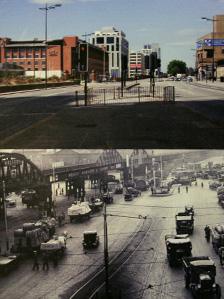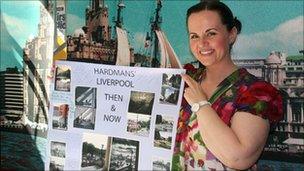Chambre Hardman Liverpool photos recreated for FACT
- Published

New images are displayed alongside Chambre Hardman's photographs
The contrast between the two pictures could not be stronger, although the location and viewpoint is exactly the same.
In one frame a grimy, smog-ridden street teeming with traffic where horse drawn vehicles lurch between crowds of dockers.
In the next, modern glass fronted buildings line up down a six lane dual carriageway, the hustle and bustle replaced by ordered traffic and pedestrians.
The images are part of an exhibition placing photographs by teenagers in 2011 next to those taken by renowned 20th century city photographer Edward Chambre Hardman.
The display, at Liverpool's Foundation for Art and Creative Technology (FACT), grew out of a visit by a group of teenagers to the photographer's old Rodney Street home, now a National Trust property.
'Completely different city'
Clare Molyneux, artistic director of West Derby based Open The Door Theatre in Education said: "When we got into the exhibition of Mr Hardman's photographs it was frustrating for me because the young people didn't recognise any of the locations.
"They couldn't recognise their own city.
"On the way back I drove them to the places just to show them and they couldn't believe it.
"The photographs showed a completely different city to the one they knew."
From the mid 1920s to the mid 1960s Edward Chambre Hardman, a portrait photographer based in Liverpool city centre, spent his spare time taking landscape pictures of the city and it's surrounding area.
When he died in 1988 his house and studio, which had changed little since the 1950s, was taken over by the E. Chambré Hardman Trust.
It later transferred to the National Trust, opening as a museum dedicated to his life's work in 2004.
The FACT exhibition contrasts Chambre Hardman's photographs with those of modern Liverpool taken by local teenagers.
The project, funded by £25,000 from the Heritage Lottery Fund, was designed to help young people learn more about their own heritage.
Detective work
Liverpool photographer Steve Judson took 100 young people from youth clubs across the city to the sites of Hardman's photographs.
To take a photograph showing the same location the group had to first pinpoint the exact spot where Chambre Hardman had stood.
"We went to the original locations where Chambre Hardman had taken the pictures and we took the same pictures, from the same angle and the same vantage point," Ms Molyneux explained.
"It was so difficult to find some places because they are so different.

Clare Molyneux said the project helped give people confidence
"We were left with the task of where to start."
The first challenge was to match Chambre Hardman's black and white prints to city locations when so many buildings have been demolished or renovated in the intervening years.
Large missing structures like The Overhead Railway, known locally as the docker's umbrella, would give some clue, while in other pictures the group had to carry out further detective work.
"On the dock road the docker's umbrella has gone, the tram lines have gone and the warehouses have gone," Ms Molyneux explained.
"On one image of the Canning Dock it was just a single lamppost on an Ordnance Survey map which gave us the clue as to where Mr Hardman had taken the photo.
"We had to work together to find the places, the group has learnt so much.
"Not only have they learnt about the history of Liverpool but they've also developed digital photography and editing skills.
"The confidence that young people get from being involved in an arts project like this is amazing."
The exhibition Hardman's Liverpool: Then and Now is at FACT, Liverpool until 22 September.